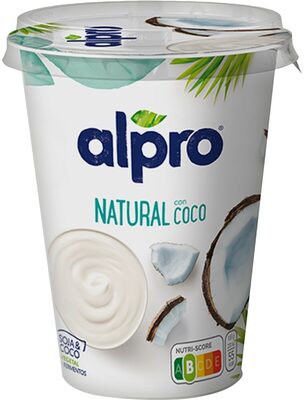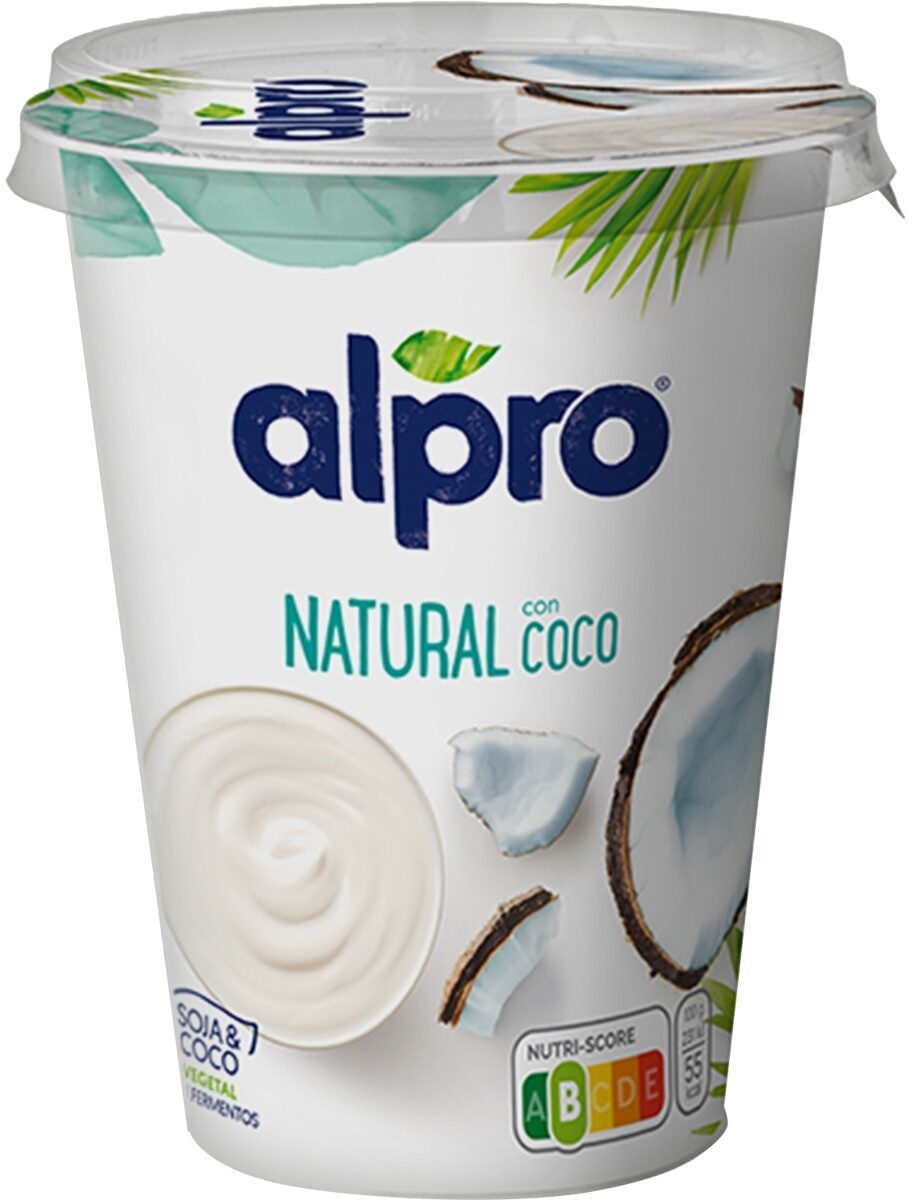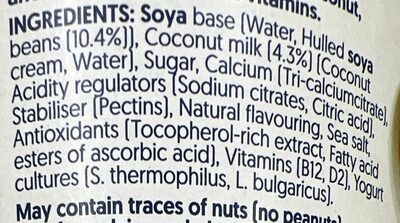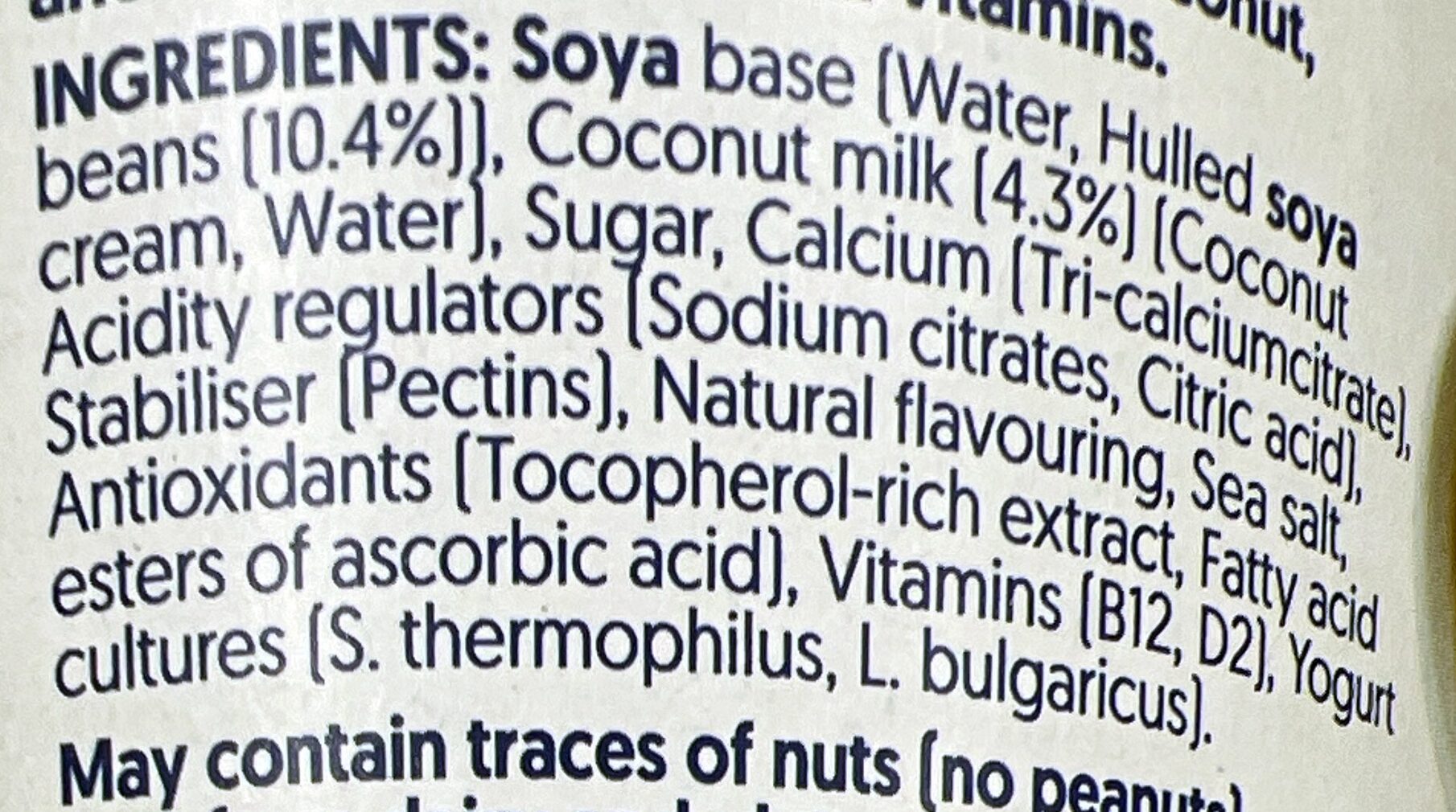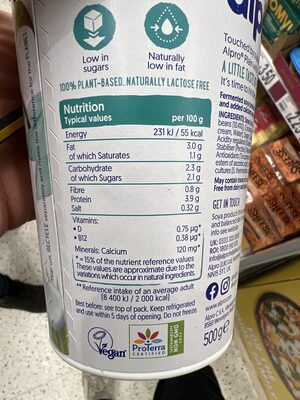Help us make food transparency the norm!
As a non-profit organization, we depend on your donations to continue informing consumers around the world about what they eat.
The food revolution starts with you!
Natural with Coconut - Alpro - 500 g
Natural with Coconut - Alpro - 500 g
Barcode: 5411188119098 (EAN / EAN-13)
Common name: Produit fermenté au soja, noix de coco, aromatisé, avec calcium et vitamines ajoutés
Quantity: 500 g
Packaging: Plastic, Cardboard, PP 5 - Polypropylene, Paperboard, de:1 Becher aus Plastik, de:1 Deckel aus Kunststoff, de:1 Folie aus Aluminium, de:1 Hülle aus Pappe
Brands: Alpro
Categories: Plant-based foods and beverages, Fermented foods, Dairy substitutes, Desserts, Non-dairy desserts, Non-dairy fermented foods, Non-dairy yogurts, Soy milk yogurts
Labels, certifications, awards:
Low or no fat, Low or no sugar, Low fat, Low sugar, No gluten, Vegetarian, Source of proteins, Vegan, 100% vegetable, Calcium source, European Vegetarian Union, European Vegetarian Union Vegan, Green Dot, High proteins, No lactose, No milk, Nutriscore, Nutriscore Grade B, Rich in vegetable protein, Triman, ProTerra Certified, Soja sans OGM



Origin of ingredients: Unspecified
Manufacturing or processing places: Belgium, United Kingdom
Countries where sold: Andorra, Austria, Belgium, Finland, France, Germany, Italy, Portugal, Spain, Switzerland, United Kingdom
Matching with your preferences
Health
Ingredients
-
25 ingredients
soy base (water, peeled soybeans (10,4%)], coconut milk (4,3%) (coconut ceme, water), sugar, tricalcium citrate, acidity regulators (sodium citrates, citric acid), stabilizer (pectins), natural flavor, sea salt, antioxidant (strong tocopherol-active extract, fatty acid ester of ascorbic acid), vitamins (b12, d2), yogurt cultures (str,thermophilus, l, bulgaricus)Allergens: SoybeansTraces: Nuts
Food processing
-
Ultra processed foods
Elements that indicate the product is in the 4 - Ultra processed food and drink products group:
- Additive: E440 - Pectins
- Ingredient: Flavouring
Food products are classified into 4 groups according to their degree of processing:
- Unprocessed or minimally processed foods
- Processed culinary ingredients
- Processed foods
- Ultra processed foods
The determination of the group is based on the category of the product and on the ingredients it contains.
Additives
-
E304 - Fatty acid esters of ascorbic acid
Ascorbyl palmitate: Ascorbyl palmitate is an ester formed from ascorbic acid and palmitic acid creating a fat-soluble form of vitamin C. In addition to its use as a source of vitamin C, it is also used as an antioxidant food additive -E number E304-. It is approved for use as a food additive in the EU, the U.S., Canada, Australia, and New Zealand.Ascorbyl palmitate is known to be broken down -through the digestive process- into ascorbic acid and palmitic acid -a saturated fatty acid- before being absorbed into the bloodstream. Ascorbyl palmitate is also marketed as "vitamin C ester".Source: Wikipedia
-
E330 - Citric acid
Citric acid is a natural organic acid found in citrus fruits such as lemons, oranges, and limes.
It is widely used in the food industry as a flavor enhancer, acidulant, and preservative due to its tart and refreshing taste.
Citric acid is safe for consumption when used in moderation and is considered a generally recognized as safe (GRAS) food additive by regulatory agencies worldwide.
-
E331 - Sodium citrates
Sodium citrate: Sodium citrate may refer to any of the sodium salts of citrate -though most commonly the third-: Monosodium citrate Disodium citrate Trisodium citrateThe three forms of the salt are collectively known by the E number E331. Sodium citrates are used as acidity regulators in food and drinks, and also as emulsifiers for oils. They enable cheeses to melt without becoming greasy.Source: Wikipedia
-
E440 - Pectins
Pectins (E440) are natural carbohydrates, predominantly found in fruits, that act as gelling agents in the food industry, creating the desirable jelly-like texture in jams, jellies, and marmalades.
Pectins stabilize and thicken various food products, such as desserts, confectioneries, and beverages, ensuring a uniform consistency and quality.
Recognized as safe by various health authorities, pectins have been widely used without notable adverse effects when consumed in typical dietary amounts.
Ingredients analysis
-
May contain palm oil
Ingredients that may contain palm oil: E304
-
Vegan
No non-vegan ingredients
Unrecognized ingredients: fr:base-de-soja, Calcium, Vitamin b12Some ingredients could not be recognized.
We need your help!
You can help us recognize more ingredients and better analyze the list of ingredients for this product and others:
- Edit this product page to correct spelling mistakes in the ingredients list, and/or to remove ingredients in other languages and sentences that are not related to the ingredients.
- Add new entries, synonyms or translations to our multilingual lists of ingredients, ingredient processing methods, and labels.
If you would like to help, join the #ingredients channel on our Slack discussion space and/or learn about ingredients analysis on our wiki. Thank you!
-
Vegetarian
No non-vegetarian ingredients detected
Unrecognized ingredients: fr:base-de-soja, Calcium, Vitamin b12Some ingredients could not be recognized.
We need your help!
You can help us recognize more ingredients and better analyze the list of ingredients for this product and others:
- Edit this product page to correct spelling mistakes in the ingredients list, and/or to remove ingredients in other languages and sentences that are not related to the ingredients.
- Add new entries, synonyms or translations to our multilingual lists of ingredients, ingredient processing methods, and labels.
If you would like to help, join the #ingredients channel on our Slack discussion space and/or learn about ingredients analysis on our wiki. Thank you!
-
Details of the analysis of the ingredients
We need your help!
Some ingredients could not be recognized.
We need your help!
You can help us recognize more ingredients and better analyze the list of ingredients for this product and others:
- Edit this product page to correct spelling mistakes in the ingredients list, and/or to remove ingredients in other languages and sentences that are not related to the ingredients.
- Add new entries, synonyms or translations to our multilingual lists of ingredients, ingredient processing methods, and labels.
If you would like to help, join the #ingredients channel on our Slack discussion space and/or learn about ingredients analysis on our wiki. Thank you!
fr: Base de soja 92.7% (eau, fèves de soja sans OGM décortiquées 10.4%), lait de coco 7.1% (crème de noix de coco, eau), sucre, calcium (citrate tricalcique), correcteurs d'acidité (citrates de sodium, acide citrique), stabilisant (pectines), arôme naturel, sel marin de table, antioxydants (extrait riche en tocophérols, esters d'acides gras de l'acide ascorbique), vitamines, vitamine B12, vitamine D2, ferments de yaourt (streptococcus thermophilus, lactobacillus bulgaricus)- Base de soja -> fr:base-de-soja - percent_min: 92.7 - percent: 92.7 - percent_max: 92.7
- eau -> en:water - vegan: yes - vegetarian: yes - ciqual_food_code: 18066 - percent_min: 82.3 - percent_max: 82.3
- fèves de soja sans OGM décortiquées -> en:gmo-free-hulled-soya-bean - vegan: yes - vegetarian: yes - ciqual_food_code: 20901 - percent_min: 10.4 - percent: 10.4 - percent_max: 10.4
- lait de coco -> en:coconut-milk - vegan: yes - vegetarian: yes - ciqual_food_code: 18041 - percent_min: 7.1 - percent: 7.1 - percent_max: 7.1
- crème de noix de coco -> en:coconut-cream - vegan: yes - vegetarian: yes - ciqual_food_code: 18041 - percent_min: 3.55 - percent_max: 7.1
- eau -> en:water - vegan: yes - vegetarian: yes - ciqual_food_code: 18066 - percent_min: 0 - percent_max: 3.55
- sucre -> en:sugar - vegan: yes - vegetarian: yes - ciqual_proxy_food_code: 31016 - percent_min: 0 - percent_max: 0.200000000000003
- calcium -> en:calcium - percent_min: 0 - percent_max: 0.100000000000001
- citrate tricalcique -> en:e333 - vegan: yes - vegetarian: yes - percent_min: 0 - percent_max: 0.100000000000001
- correcteurs d'acidité -> en:acidity-regulator - percent_min: 0 - percent_max: 0.100000000000001
- citrates de sodium -> en:e331 - vegan: yes - vegetarian: yes - percent_min: 0 - percent_max: 0.100000000000001
- acide citrique -> en:e330 - vegan: yes - vegetarian: yes - percent_min: 0 - percent_max: 0.100000000000001
- stabilisant -> en:stabiliser - percent_min: 0 - percent_max: 0.100000000000001
- pectines -> en:e440a - vegan: yes - vegetarian: yes - percent_min: 0 - percent_max: 0.100000000000001
- arôme naturel -> en:natural-flavouring - vegan: maybe - vegetarian: maybe - percent_min: 0 - percent_max: 0.100000000000001
- sel marin de table -> en:sea-salt - vegan: yes - vegetarian: yes - ciqual_food_code: 11082 - percent_min: 0 - percent_max: 0.100000000000001
- antioxydants -> en:antioxidant - percent_min: 0 - percent_max: 0.100000000000001
- extrait riche en tocophérols -> en:e306 - vegan: yes - vegetarian: yes - percent_min: 0 - percent_max: 0.100000000000001
- esters d'acides gras de l'acide ascorbique -> en:e304 - vegan: maybe - vegetarian: maybe - from_palm_oil: maybe - percent_min: 0 - percent_max: 0.100000000000001
- vitamines -> en:vitamins - vegan: yes - vegetarian: yes - percent_min: 0 - percent_max: 0.100000000000001
- vitamine B12 -> en:vitamin-b12 - percent_min: 0 - percent_max: 0.100000000000001
- vitamine D2 -> en:ergocalciferol - vegan: yes - vegetarian: yes - percent_min: 0 - percent_max: 0.100000000000001
- ferments de yaourt -> en:yogurt-cultures - vegan: maybe - vegetarian: yes - percent_min: 0 - percent_max: 0.100000000000001
- streptococcus thermophilus -> en:streptococcus-thermophilus - vegan: maybe - vegetarian: yes - percent_min: 0 - percent_max: 0.100000000000001
- lactobacillus bulgaricus -> en:lactobacillus-bulgaricus - vegan: maybe - vegetarian: yes - percent_min: 0 - percent_max: 0.100000000000001
Nutrition
-
Good nutritional quality
⚠ ️Warning: the amount of fruits, vegetables and nuts is not specified on the label, it was estimated from the list of ingredients: 17This product is not considered a beverage for the calculation of the Nutri-Score.
Positive points: 2
- Proteins: 2 / 5 (value: 3.9, rounded value: 3.9)
- Fiber: 0 / 5 (value: 0.9, rounded value: 0.9)
- Fruits, vegetables, nuts, and colza/walnut/olive oils: 0 / 5 (value: 17.5, rounded value: 17.5)
Negative points: 2
- Energy: 0 / 10 (value: 231, rounded value: 231)
- Sugars: 0 / 10 (value: 2.3, rounded value: 2.3)
- Saturated fat: 1 / 10 (value: 1.1, rounded value: 1.1)
- Sodium: 1 / 10 (value: 96, rounded value: 96)
The points for proteins are counted because the negative points are less than 11.
Nutritional score: (2 - 2)
Nutri-Score:
-
Nutrient levels
-
Fat in low quantity (2.9%)
What you need to know- A high consumption of fat, especially saturated fats, can raise cholesterol, which increases the risk of heart diseases.
Recommendation: Limit the consumption of fat and saturated fat- Choose products with lower fat and saturated fat content.
-
Saturated fat in low quantity (1.1%)
What you need to know- A high consumption of fat, especially saturated fats, can raise cholesterol, which increases the risk of heart diseases.
Recommendation: Limit the consumption of fat and saturated fat- Choose products with lower fat and saturated fat content.
-
Sugars in low quantity (2.3%)
What you need to know- A high consumption of sugar can cause weight gain and tooth decay. It also augments the risk of type 2 diabetes and cardio-vascular diseases.
Recommendation: Limit the consumption of sugar and sugary drinks- Sugary drinks (such as sodas, fruit beverages, and fruit juices and nectars) should be limited as much as possible (no more than 1 glass a day).
- Choose products with lower sugar content and reduce the consumption of products with added sugars.
-
Salt in low quantity (0.24%)
What you need to know- A high consumption of salt (or sodium) can cause raised blood pressure, which can increase the risk of heart disease and stroke.
- Many people who have high blood pressure do not know it, as there are often no symptoms.
- Most people consume too much salt (on average 9 to 12 grams per day), around twice the recommended maximum level of intake.
Recommendation: Limit the consumption of salt and salted food- Reduce the quantity of salt used when cooking, and don't salt again at the table.
- Limit the consumption of salty snacks and choose products with lower salt content.
-
-
Nutrition facts
Nutrition facts As sold
for 100 g / 100 mlCompared to: Soy milk yogurts Energy 231 kj
(55 kcal)-22% Fat 2.9 g +32% Saturated fat 1.1 g +206% Carbohydrates 2.4 g -71% Sugars 2.3 g -68% Fiber 0.9 g -4% Proteins 3.9 g +3% Salt 0.24 g +114% Vitamin D 0.75 µg -14% Vitamin B12 (cobalamin) 0.38 µg -1% Calcium 120 mg -1% Fruits‚ vegetables‚ nuts and rapeseed‚ walnut and olive oils (estimate from ingredients list analysis) 17.5 %
Environment
-
Eco-Score B - Low environmental impact
⚠ ️Select a country in order to include the full impact of transportation.The Eco-Score is an experimental score that summarizes the environmental impacts of food products.→ The Eco-Score was initially developped for France and it is being extended to other European countries. The Eco-Score formula is subject to change as it is regularly improved to make it more precise and better suited to each country.Life cycle analysis
-
Average impact of products of the same category: A (Score: 97/100)
Category: Soy dessert, plain, refrigerated
Category: Soy dessert, plain, refrigerated
- PEF environmental score: 0.10 (the lower the score, the lower the impact)
- including impact on climate change: 0.83 kg CO2 eq/kg of product
Stage Impact Agriculture
19.9 %Processing
37.5 %Packaging
15.1 %Transportation
16.3 %Distribution
8.8 %Consumption
2.4 %
Bonuses and maluses
-
Origins of ingredients with a high impact
Malus: -5
Environmental policy: -5
Transportation: 0
Origin of the product and/or its ingredients % of ingredients Impact Unspecified 100 %High
-
Packaging with a medium impact
Malus: -12
Shape Material Recycling Impact 1 Lid PP 5 - Polypropylene High 1 Film Light aluminium Medium 1 Pot Plastic High
Eco-Score for this product
-
Impact for this product: B (Score: 79/100)
Product: Natural with Coconut - Alpro - 500 g
Life cycle analysis score: 97
Sum of bonuses and maluses: -17
Final score: 79/100 (The score of products with non-recyclable and non-biodegradable packaging materials is capped at 79 (grade B).)
-
Carbon footprint
-
Equal to driving 0.4 km in a petrol car
83 g CO² per 100g of product
The carbon emission figure comes from ADEME's Agribalyse database, for the category: Soy dessert, plain, refrigerated (Source: ADEME Agribalyse Database)
Stage Impact Agriculture
17.0 %Processing
30.5 %Packaging
22.2 %Transportation
25.0 %Distribution
4.5 %Consumption
0.8 %
Packaging
-
Packaging with a medium impact
-
Packaging parts
1 x Lid (PP 5 - Polypropylene)
1 x Film (Aluminium)
1 x Pot (Plastic)
-
Packaging materials
Material % Packaging weight Packaging weight per 100 g of product Plastic Metal Total
-
Transportation
-
Origins of ingredients
Origins of ingredients with a high impact
Origin of the product and/or its ingredients % of ingredients Impact Unspecified 100 %High
Report a problem
-
Incomplete or incorrect information?
Category, labels, ingredients, allergens, nutritional information, photos etc.
If the information does not match the information on the packaging, please complete or correct it. Open Food Facts is a collaborative database, and every contribution is useful for all.
Data sources
Product added on by max4food
Last edit of product page on by aleene.
Product page also edited by additives-app-chakib, archie, axvonder, charlesnepote, chevalstar, countrybot, date-limite-app, driveoff, dsanzh, ecoscore-impact-estimator, elcoco, emericl, fiffi, foodless, foodvisor, gmlaa, inf, iri-iresfe, jatiku, kiliweb, lianhua, magasins-u, manuquinoa, manutopo, marie321, monsieurtanuki, moon-rabbit, musarana, mvainola, neptuno, neugartf, nexty, october-food-facts, off.74dc73df-3dfb-4840-a628-2e76bf137edd, openfoodfacts-contributors, osg, packbot, product-scanner, professordoc, quechoisir, quentinbrd, recycling-app, roboto-app, scanbot, simclem, smoothie-app, sne1991, swipe-studio, thaialagata, vaporous, yuka.U3FVTURLOFJwT1FocHRnazhqM1M2c3BSbWNmMGMzbWFGdEJOSVE9PQ, yuka.Uks0K1NLSWppT0ZVdXNNMzNValJvdlZROTV5bUFVNmJlOGNoSVE9PQ, yuka.VEwwOUc0a2NuOXBTaXZJODBEUDQ4L0p6M01PSFVIcnNNdkE2SUE9PQ, yuka.VklwWUY2Y0lwY0VHbXZFNjVFTEhwT05UbHMrRGNHNnJDc2xBSUE9PQ, yuka.WFBnYkc0VU5ndWdta01ZRDNBM2Z3ZEJsNTRLbERUS3NCc015SVE9PQ, yuka.ZEtvZUlMWTZuOVFCdmNFWXJ4TDJ4OVpRNGNDRmNYS2JDdGhNSUE9PQ, yukafix.
Last check of product page on by aleene.
